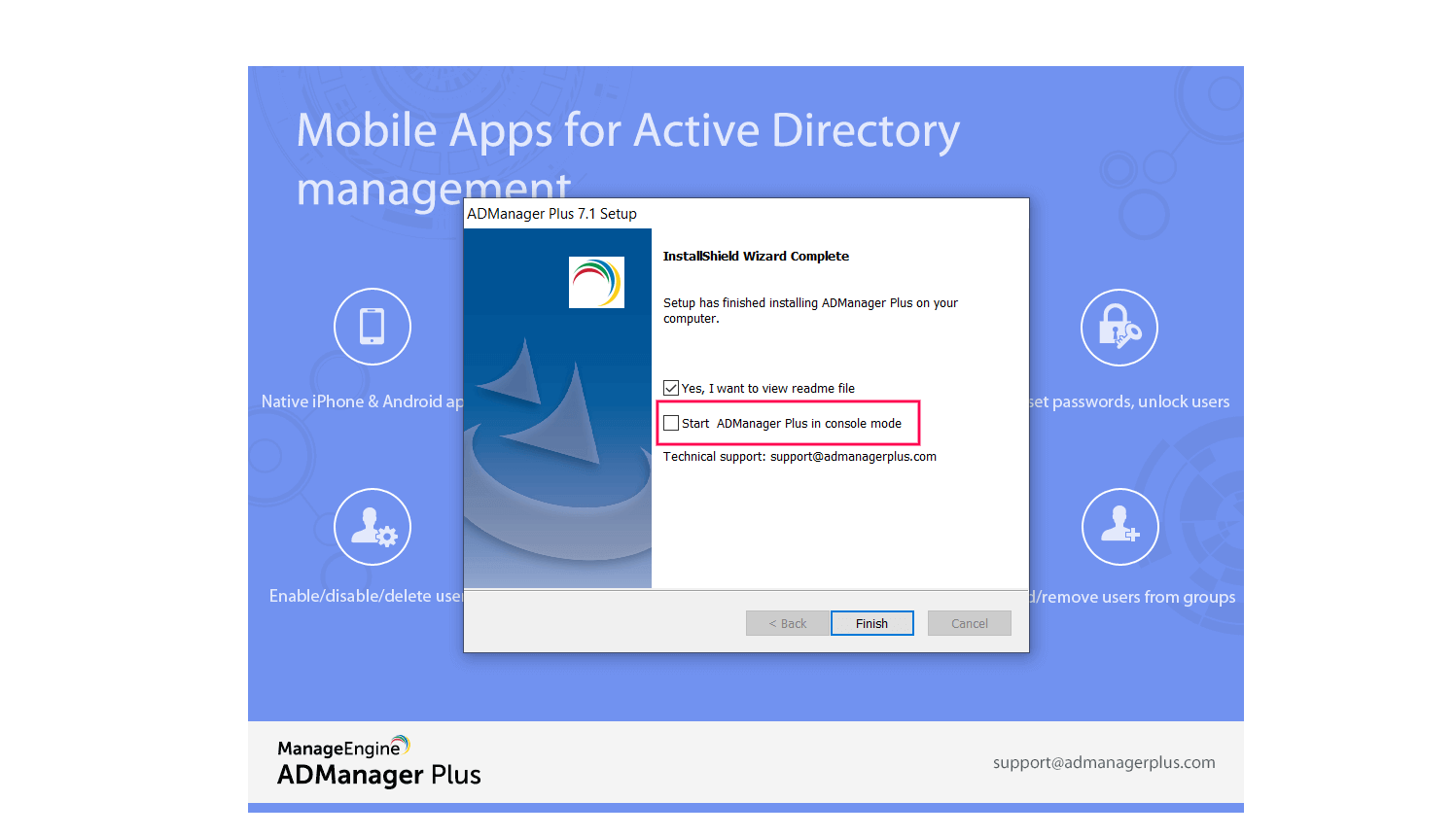How to update ADManager Plus' built-in PostgreSQL database
Steps to update your ADManager Plus instance's PostgreSQL database
- Stop ADManager Plus by navigating to Start > All Programs > ADManager Plus > Stop ADManager Plus.
Note: If you have installed ADManager Plus as a Microsoft Windows service, stop the service by navigating to Start > Run > services.msc > ManageEngine ADManager Plus > Stop.
- Navigate to <Installation Directory>\ADManager Plus\bin and execute the backupDB.bat file to back up the database of your current installation. This will create a folder called Backup inside ADManager Plus' installation folder (<Installation Directory>\ADManager Plus\Backup), which will contain your database backup file (e.g., OfflineBackup_20161129235853.ezip).Note:
- You can also do this by running Command Prompt as an administrator, navigating to <Installation Directory>\ADManager Plus\bin, and executing the backupDB.bat file.
- ADManager plus uses a CryptTag value as its default database backup file password for enhanced protection, and this can be found in the customer-config.xml file.
- Make a copy of the following folders and files:
- Archive, ES, and esdata folders from the installation folder of your existing ADManager Plus instance (<Installation Directory>\ADManager Plus).
- Customer-config.xml file of your existing ADManager Plus instance from the <Installation Directory>\ADManager Plus\conf folder.
- If you are going to install your new ADManager Plus instance on the same server,
- Navigate to the InstallShield Installation Information folder (C:\Program Files (x86)\InstallShield Installation Information) and rename the CC00BC3F-40AE-49A7-BA63-FE2F93D20585 folder to CC00BC3F-40AE-49A7-BA63-FE2F93D20585_bak.Note: The InstallShield Installation Information folder is a hidden folder and can be viewed by clicking the View tab in File Explorer and checking Hidden items.
- Locate and rename the existing installation folder.
e.g., If you've installed ADManager Plus in the default location, navigate to (C:\Program Files\ManageEngine) and rename the ADManager Plus folder to ADManager Plus_old.
- Navigate to the InstallShield Installation Information folder (C:\Program Files (x86)\InstallShield Installation Information) and rename the CC00BC3F-40AE-49A7-BA63-FE2F93D20585 folder to CC00BC3F-40AE-49A7-BA63-FE2F93D20585_bak.
- Now, download and install the latest build of ADManager Plus from here. Do not start the product after installation. This can be done by unchecking the Start ADManager Plus in console mode option in the setup window.
- Paste the copied Archive, ES, and esdata folders in the installation folder of your new ADManager Plus instance (<Installation Directory>\ADManager Plus).
- Locate and replace the new customer-config.xml file with the copied customer-config.xml file from step 3.
- Obtain the backup file of your old instance and paste it in the bin folder (<Installation Directory>\ADManager Plus\bin) of your new ADManager Plus instance.
- Restore the database backup by running Command Prompt as an administrator, navigating to <Installation Directory>\ADManager Plus\bin and executing the batch file, restoreDB.bat, in the following format:
restoreDB.bat backupFileName -p
(e.g., restoreDB.bat OfflineBackup_20230215191814.ezip -p) - Now start the product.
Steps to check your PostgreSQL database's version
- If you are running ADManager Plus build 7150 and above:
- Log in to ADManager Plus and navigate to Support.
- Under Upload Logs, click More.
- Under Product Information, find the Database type.
- If you're running other ADManager Plus build versions:
- Navigate to <Installation Directory>\ADManager Plus\pgsql\bin.
- Execute the following command:
psql.exe -V

